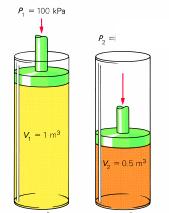Since
![]() ,
If we change one of the variables, (P, V, n, or T) then one or more of
the
other variables must also change. This
leads to the equation
,
If we change one of the variables, (P, V, n, or T) then one or more of
the
other variables must also change. This
leads to the equation
![]() or if the number of moles stays the
same
or if the number of moles stays the
same
![]() .
.
Boyle's Law:
Boyle's Law examines the effect of changing volume on Pressure.
To isolate these variables, temperature must remain constant.
We can eliminate temperature from both sides of the equation and
we are
left with P1V1= P2V2
![]()
Sample Problem: A piston with a volume of gas of 1.0 m3 at 100 kPa is compressed to a final volume of 0.50 m3. What is the final pressure?

P1 is 100 kPa
V1 is 1.0 m3
V2 is 0.50 m3
P2 is unknown
Charles's Law examines the effect of changing temperature on volume. To isolate these variables, pressure must remain constant.
![]() so Charles's law is
so Charles's law is
![]()
Sample problem: A piston with a volume of gas of 1.0 m3 at 273 K is cooled to a temperature of 136.5 K. What is the final volume? (Assume pressure is kept constant.)

T1 is 273 K
V1 is 1.0 m3
V2 is unknown
T2 is 136.5 K

Charles
law Applet See what happens when you increase
temperature.
Increasing temperature __________ pressure.
GUY-LUSSAC'S LAW
Near the turn of the 19th century, Guy-Lussac investigated the
relationship between pressure and temperature while the volume was held
constant. When the temperature goes up the pressure inside a
rigid container also goes up. For example, your car tires, when
inflated, are essentially rigid, the volume will not change. Did
you notice that when the temperature goes up the pressure inside your
tires also increases?
We can again use the combined gas law to quantify this relationship.
Sample Problem: If your
tire is two liters and the initial pressure is 2 atm, what is the final
pressure when the temperature goes from 0 degrees celcius (273 K) to
100 degrees celcius (373 K)?
T1 is 273 K
P1 is 2 atm
P2 is unknown
T2 is 373 K
First, start with the combined
gas law and cancel out the volumes because they do not change.

After removing the volumes,

Rearranging the equation:
 so the final pressure P2, is (2.00
atm)(373K)/(273 K) = 2.73 atm
so the final pressure P2, is (2.00
atm)(373K)/(273 K) = 2.73 atm